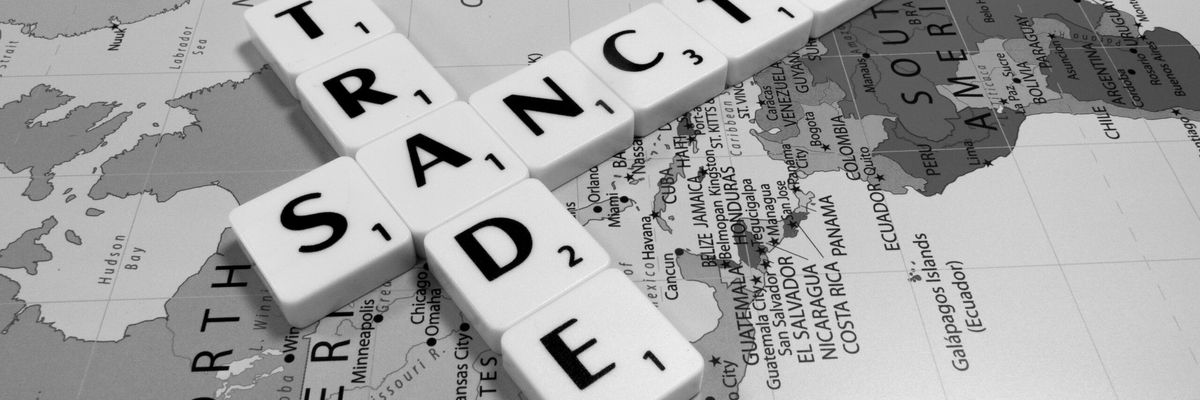In his memoir “The Room Where It Happened,” former national security adviser John Bolton writes about Donald Trump's maximum pressure campaign on Tehran, a policy whose central goal was to cripple the Iranian economy to the point of capitulation with over 1,500 sanctions.
Bolton writes that Trump's sanctions were not as "maximum" as he would have hoped, but that they "demonstrated a seriousness of intention." Indeed, Bolton did not believe that the sanctions would change Iran's behavior. But his insistence on their "seriousness of intention" reveals the real purpose that sanctions serve in U.S. foreign policy. Even as sanctions have proven ineffective at achieving ambitious U.S. goals, they have become the United States’ tool of first resort for communicating opposition to foreign governments. Those who suffer the brunt of the harm, however, are ordinary civilians, not political leaders.
Rather than using sanctions as a diplomatic tool for achieving concessions, the United States wields its economic might to isolate and punish countries to no avail. In a webinar hosted by the Quincy Institute last Wednesday, Asli Bali, UCLA Law Professor and Director of the Promise Institute for Human Rights, said that "sanctions are as much part of the story of forever war, and therefore as much susceptible to the logics of restraint." At a time when Americans are increasingly contending with and challenging U.S. military engagements abroad, it is time to rethink our use of broad-based economic sanctions.
Sanctions are an indiscriminate weapon — they make no distinction between civilian and military targets and hurt the most vulnerable of a society rather than its political elites. Sanctions target anything from medications to spare parts to grain shipments to, in the case of Iraq, pencils for school children. The very goods that sanctions target are directly tied to civilians, which is why Bali argues that in many cases, the civilian harm caused by sanctions surpasses what would be admissible on the battlefield.
Recent research reveals just how much devastation U.S. maximum pressure campaigns have caused in Syria, Iran, and Venezuela. Today, more than 9.3 million Syrians have become food insecure and are increasingly dependent on government handouts. Sanctions obstruct the country's ability to rebuild its damaged infrastructure, so much so that U.N. human rights expert Alena Douhan called on the United States to lift its unilateral sanctions, as they "violate the human rights of the Syrian people."
In Iran, sanctions have induced shortages in medicine and impeded the country's fight against COVID-19. In Venezuela, sanctions are causing shortages in clean water, electricity, food, and medical equipment. Only around 20 percent of Venezuelan medical equipment is currently functional, and a 2019 report found that sanctions have caused an estimated 40,000 excess deaths in the country. The irony is that sanctions are ostensibly introduced to improve human rights. Instead, the instrument has become a human rights violator itself.
Today, the United States has sanctions programs against more than 30 states or territories. Biden has yet to repeal the draconian sanctions of the Trump administration.
If sanctions rarely work and have disastrous human rights consequences, why are they still America's favorite weapon? Sanctions are a cheap tool, with almost no domestic costs to the United States. From the 1990s onwards, they have been used against countries when the stakes are not high enough for military action. And unlike diplomacy, sanctions do not require any give-and-take. As journalist Peter Beinart noted in the aforementioned webinar, sanctions operate on "this mythic idea that as long as we keep punishing these countries, eventually they're just going to fold, the regimes are going to collapse." This collective myth that punitive coercion can achieve ambitious goals like regime change suspends the debate in Congress. There is no talk of offering concessions to targeted countries or lifting sanctions in exchange for changes in behavior. Concessions and positive incentives are viewed as appeasement.
Sanctions also introduce domestic audience costs. Policymakers gain approval for imposing sanctions and taking a moral stance against an authoritarian government. Lifting those sanctions would be seen by domestic audiences as backing down from an adversary. As a result, policymakers take a regime-change-or-nothing approach.
In most cases, sanctions are used to keep a country as weak as possible by isolating it from the global economy. After the Cold War, the Clinton administration used sanctions to exclude "backlash states"— Iraq, Iran, Libya, Cuba, and North Korea — from the global family of nations. Countries which did not comply with the imperatives of the liberal order were cast out as pariahs. The United States embraced sanctions during the 90s and hasn't looked back since.
The United States’ overuse of sanctions impedes the productive exploration of alternative policy options, in the same way that endless wars shut down diplomatic channels. What America needs are strategies that engage it diplomatically. This means expanding its arsenal of tools, defining attainable political objectives, and fashioning tools to meet those objectives. It also means that Washington needs to desert lofty, unrealistic goals and accept the limits of its own power.
Beinart argued that "nobody wants to step forward and say, whether these are good outcomes or not, we don't have the power to achieve them." Syria expert Joshua Landis agreed: "We really don't have the tools and the ability to make people democratic, to make countries democratic that aren't democratic." America inflates its perception of what it can do around the world, and to reach these inflated goals, continually wields an ill-suited and morally indefensible weapon.
President Biden has declared that "diplomacy is back." He has already taken steps to prove this, by negotiating with Iran in Vienna and vowing to withdraw troops from Afghanistan by September 11. For diplomacy to be "back," however, the administration must also abandon America's overuse of sanctions and formulate more tactful and humane ways of engaging with the world.















